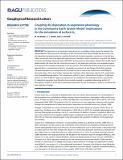| dc.contributor.author | Val Martin, M. | |
| dc.contributor.author | Arnold, S. R. | |
| dc.contributor.author | Heald, Colette L. | |
| dc.date.accessioned | 2014-09-12T18:36:47Z | |
| dc.date.available | 2014-09-12T18:36:47Z | |
| dc.date.issued | 2014-04 | |
| dc.date.submitted | 2014-02 | |
| dc.identifier.issn | 00948276 | |
| dc.identifier.uri | http://hdl.handle.net/1721.1/89479 | |
| dc.description.abstract | Dry deposition is an important removal process controlling surface ozone. We examine the representation of this ozone loss mechanism in the Community Earth System Model. We first correct the dry deposition parameterization by coupling the leaf and stomatal vegetation resistances to the leaf area index, an omission which has adversely impacted over a decade of ozone simulations using both the Model for Ozone and Related chemical Tracers (MOZART) and Community Atmospheric Model-Chem (CAM-Chem) global models. We show that this correction increases O[subscript 3] dry deposition velocities over vegetated regions and improves the simulated seasonality in this loss process. This enhanced removal reduces the previously reported bias in summertime surface O[subscript 3] simulated over eastern U.S. and Europe. We further optimize the parameterization by scaling down the stomatal resistance used in the Community Land Model to observed values. This in turn further improves the simulation of dry deposition velocity of O[subscript 3], particularly over broadleaf forested regions. The summertime surface O[subscript 3] bias is reduced from 30 ppb to 14 ppb over eastern U.S. and 13 ppb to 5 ppb over Europe from the standard to the optimized scheme, respectively. O[subscript 3] deposition processes must therefore be accurately coupled to vegetation phenology within 3-D atmospheric models, as a first step toward improving surface O[subscript 3] and simulating O[subscript 3] responses to future and past vegetation changes. | en_US |
| dc.description.sponsorship | United States. National Park Service (Grant H2370 094000/J2350103006) | en_US |
| dc.description.sponsorship | National Science Foundation (U.S.) (AGS-1238109) | en_US |
| dc.description.sponsorship | Joint Fire Science Program (U.S.) (Project 13-1-01-4) | en_US |
| dc.language.iso | en_US | |
| dc.publisher | American Geophysical Union (AGU) | en_US |
| dc.relation.isversionof | http://dx.doi.org/10.1002/2014GL059651 | en_US |
| dc.rights | Article is made available in accordance with the publisher's policy and may be subject to US copyright law. Please refer to the publisher's site for terms of use. | en_US |
| dc.source | MIT web domain | en_US |
| dc.title | Coupling dry deposition to vegetation phenology in the Community Earth System Model: Implications for the simulation of surface O[subscript 3] | en_US |
| dc.type | Article | en_US |
| dc.identifier.citation | Val Martin, M., C. L. Heald, and S. R. Arnold. “ Coupling Dry Deposition to Vegetation Phenology in the Community Earth System Model: Implications for the Simulation of Surface O[subscript 3].” Geophys. Res. Lett. 41, no. 8 (April 16, 2014): 2988–2996. © 2014 American Geophysical Union | en_US |
| dc.contributor.department | Massachusetts Institute of Technology. Department of Civil and Environmental Engineering | en_US |
| dc.contributor.mitauthor | Heald, Colette L. | en_US |
| dc.relation.journal | Geophysical Research Letters | en_US |
| dc.eprint.version | Final published version | en_US |
| dc.type.uri | http://purl.org/eprint/type/JournalArticle | en_US |
| eprint.status | http://purl.org/eprint/status/PeerReviewed | en_US |
| dspace.orderedauthors | Val Martin, M.; Heald, C. L.; Arnold, S. R. | en_US |
| dc.identifier.orcid | https://orcid.org/0000-0003-2894-5738 | |
| mit.license | PUBLISHER_POLICY | en_US |
| mit.metadata.status | Complete | |
